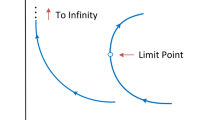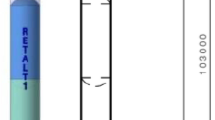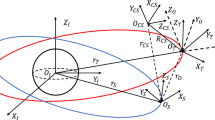Abstract
This paper addresses the time-optimal roto-translational orbital rendezvous maneuver for an inertially asymmetric rigid spacecraft in an all-thrusters configuration. To begin with, the target and chaser relative rotational and translational dynamics are driven. Then, in the presence of torque and force constraints, the simultaneously time-optimal attitude and position control problem is numerically solved using the pseudo-spectral method. The costates are then computed to establish the first-order optimality of the obtained solutions, which is confirmed by satisfying Pontryagin's minimum principle. It is demonstrated via simulation that the obtained control forces and moments are basically “bang-bang,” which is the most natural and convenient form for on–off thrusters.

















Similar content being viewed by others
Data Availability
Some or all data, models, or code generated or used during the study are available in a repository or online in accordance with funder data retention policies.
Abbreviations
- \({\left[{{\varvec{v}}}_{B}^{L}\right]}^{L}\) :
-
Velocity vector of the chaser's body center of mass (\(B\)) with respect to the target's LVLH frame (\(L\)), expressed in the target's LVLH coordinates (\(L\))
- \({\left[{{\varvec{s}}}_{BL}\right]}^{L}\) :
-
Position vector of the chaser's body center of mass (\(B\)) with respect to the target's LVLH frame origin (\(L\)), expressed in the target's LVLH coordinates (\(L\))
- \({D}^{Y}{\varvec{x}}\) :
-
Time derivative of vector \({\varvec{x}}\) with respect to frame \(Y\)
- \({\left[{\varvec{f}}\right]}^{L}\) :
-
Control force vector, expressed in the target's LVLH coordinate system (\(L\))
- \({\left[{\varvec{f}}\right]}^{B}\) :
-
Control force vector, expressed in the chaser's body coordinate system (\(B\))
- \({m}_{B}\) :
-
Chaser’s mass
- \({\omega }_{n}\) :
-
Orbital mean angular rate of the target
- \({{\varvec{I}}}_{B}\) :
-
Inertial matrix of the chaser's body
- \({\left[{{\varvec{\omega}}}^{\alpha \beta }\right]}^{\gamma }\) :
-
Angular velocity vector of frame \(\alpha\) with respect to frame \(\beta\), expressed in coordinate system \(\gamma\)
- \({\left[{\varvec{m}}\right]}^{B}\) :
-
Control torque vector, expressed in the chaser's body coordinate system (\(B\))
- \({[{\varvec{\sigma}}]}^{BL}\) :
-
MRP vector representing the orientation of the target's LVLH frame w.r.t. the chaser's body frame
- \({e}_{x}\) , \({e}_{y}\) , \({e}_{z}\) :
-
Components of Euler axis
- \(\Phi\) :
-
Principal rotation angle
- \({[{\varvec{T}}]}^{LB}\) :
-
Transformation matrix from the chaser's body coordinates to the target's LVLH coordinates
- \([{{\varvec{\Sigma}}]}^{BL}\) :
-
Skew-symmetric form of \({[{\varvec{\sigma}}]}^{BL}\)
- \(J\) :
-
Cost function
- \(\phi\) :
-
Scalar boundary constraint in cost function
- \(g\) :
-
Integrand function in cost function
- \({\varvec{x}}\) :
-
State vector
- \({\varvec{u}}\) :
-
Control input vector
- \({\varvec{f}}\) :
-
Dynamic constraints
- \(\boldsymbol{\varphi }\) :
-
Boundary conditions
- \({\varvec{C}}\) :
-
Inequality path constraints
- \(t\) :
-
Time
- \(\tau\) :
-
Transformed time
- \({P}_{N}\) :
-
\({N}^{th}\)-Degree Legendre polynomial
- \({\varvec{X}}\) :
-
Approximated state trajectory
- \({\varvec{U}}\) :
-
Approximated control trajectory
- \({L}_{i}\) :
-
Lagrange polynomials \((i=0,\dots ,N)\)
- \({L}_{i}^{*}\) :
-
Lagrange polynomials \((i=1,\dots ,N)\)
- \(w\) :
-
Gauss weights
- \({\varvec{D}}\) :
-
Differential approximation matrix
- \({\mathcal{L}}^{\left(1\right)}\) , \({\mathcal{L}}^{\left({\varvec{P}}\right)}\) , \({\mathcal{L}}_{({\varvec{r}})}^{({\varvec{r}}+1)}\) :
-
Initial constraints for the first phase, terminal constraints for the last phase (\(P\)), and continuity constraints for the interior phases
- \(H\) :
-
Hamiltonian
- \({\varvec{\lambda}}\) :
-
Costate vector
- \({\varvec{\mu}}\) :
-
Lagrange multiplier associated with the path constraint
- \({\varvec{\nu}}\) :
-
Lagrange multiplier associated with the the boundary condition
- \({\varvec{\Lambda}}\) :
-
Estimated costates in LG points
- \(\widetilde{{\varvec{\Lambda}}}\) :
-
KKT multipliers
- \({n}_{I}\) :
-
Number of phases
- \({n}_{LG}\) :
-
Number of LG points in each phase
- \({{\varvec{B}}}_{u}\), \({{\varvec{B}}}_{{\varvec{l}}}\) :
-
Upper and lower bound of states and controls values
- \({{\varvec{S}}}_{0}\) :
-
Initial guess for states and controls values in LG points
- \(x,y,z\) :
-
Components of a vector in arbitrary coordinate system
- \(0\) :
-
Initial time
- \(f\) :
-
Terminal time
References
Karpenko, M., Bhatt, S., Bedrossian, N., Fleming, A., Ross, I.: First flight results on time-optimal spacecraft slews. J. Guid. Control Dyn. 35, 367–376 (2012). https://doi.org/10.2514/1.54937
Ma, Z., Ma, O., Shashikanth, B.N.: Optimal approach to and alignment with a rotating rigid body for capture. J. Astronaut. Sci. 55, 407–419 (2007)
Tournes, C., Shtessel, Y.: Automatic docking using optimal control and second order sliding mode control. In: AIAA Guidance, Navigation and Control Conference and Exhibit (2007)
Chen, X.-Q., Yu, J.: Optimal mission planning of GEO on-orbit refueling in mixed strategy. Acta Astronaut. 133, 63–72 (2017)
Abdollahzadeh, P., Esmailifar, S.M.: Automatic orbital docking with tumbling target using sliding mode control. Adv. Space Res. 67, 1506–1525 (2021). https://doi.org/10.1016/j.asr.2020.12.016
Ma, J., Wen, C., Zhang, C.: Practical optimization of low-thrust minimum-time orbital rendezvous in sun-synchronous orbits. Comput. Model. Eng. Sci. 126, 617–644 (2021)
Bilimoria, K.D., Wie, B.: Time-optimal three-axis reorientation of a rigid spacecraft. J. Guid. Control Dyn. 16, 446–452 (1993). https://doi.org/10.2514/3.21030
Bai, X., Junkins, J.L.: New results for time-optimal three-axis reorientation of a rigid spacecraft. J. Guid. Control Dyn. 32, 1071–1076 (2009). https://doi.org/10.2514/1.43097
Shen, H., Tsiotras, P.: Time-optimal control of axisymmetric rigid spacecraft using two controls. J. Guid. Control Dyn. 22, 682–694 (1999). https://doi.org/10.2514/2.4436
Pager, E.R., Rao, A.V.: Minimum-time reorientation of axisymmetric rigid spacecraft using three controls. J. Spacecr. Rockets 59, 2195–2201 (2022)
Hu, Y., Wu, B., Geng, Y., Wu, Y.: Smooth time-optimal attitude control of spacecraft. Proc. Inst. Mech. Eng. G 233, 2331–2343 (2019). https://doi.org/10.1177/0954410018776531
Jinsong, L., Fullmer, R., Yang Quan, C.: Time-optimal magnetic attitude control for small spacecraft. In: 2004 43rd IEEE Conference on Decision and Control (CDC) (IEEE Cat. No.04CH37601), pp. 255–260 (2004)
Olivares, A., Staffetti, E.: Hybrid switched time-optimal control of underactuated spacecraft. Acta Astronaut. 145, 456–470 (2018). https://doi.org/10.1016/j.actaastro.2018.01.051
Olivares, A., Staffetti, E.: Time-optimal attitude scheduling of a spacecraft equipped with reaction wheels. Int. J. Aerosp. Eng. 2018, 1–14 (2018). https://doi.org/10.1155/2018/5947521
Melton, R.: Numerical analysis of constrained, time-optimal satellite reorientation. Math. Probl. Eng. 2012, 1–19 (2012). https://doi.org/10.1155/2012/769376
Melton, R.G.: Maximum-likelihood estimation optimizer for constrained, time-optimal satellite reorientation. Acta Astronaut. 103, 185–192 (2014). https://doi.org/10.1016/j.actaastro.2014.06.032
Spiller, D., Ansalone, L., Curti, F.: Particle swarm optimization for time-optimal spacecraft reorientation with keep-out cones. J. Guid. Control Dyn. 39, 312–325 (2016). https://doi.org/10.2514/1.G001228
Spiller, D., Melton, R.G., Curti, F.: Inverse dynamics particle swarm optimization applied to constrained minimum-time maneuvers using reaction wheels. Aerosp. Sci. Technol. 75, 1–12 (2018). https://doi.org/10.1016/j.ast.2017.12.038
Yang, J., Stoll, E.: Time-optimal Spacecraft Reorientation with Attitude Constraints Based on A Two-stage Strategy. In: AAS/AIAA Astrodynamics Specialist Conference (2018)
Celani, F., Bruni, R.: Minimum-time spacecraft attitude motion planning using objective alternation in derivative-free optimization. J. Optim. Theory Appl. 191, 776–793 (2021). https://doi.org/10.1007/s10957-021-01834-x
Miele, A., Weeks, M., Ciarcia, M.: Optimal trajectories for spacecraft rendezvous. J. Optim. Theory Appl. 132, 353–376 (2007)
Zhang, J., Parks, G.: Multi-objective optimization for multiphase orbital rendezvous missions. J. Guid. Control Dyn. 36, 622–629 (2013)
Harris, M.W., Açıkmeşe, B.: Minimum time rendezvous of multiple spacecraft using differential drag. J. Guid. Control Dyn. 37, 365–373 (2014)
Kollin, E.M.: Autonomous time-optimal spacecraft rendezvous and proximity operations using stabilized continuation (2016)
Zhang, G., Ye, D.: Optimal short-range rendezvous using on–off constant thrust. Aerosp. Sci. Technol. 69, 209–217 (2017)
Jorgensen, M.K., Sharf, I.: Optimal planning for a multiple space debris removal mission using high-accuracy low-thrust transfers. Acta Astronaut. 172, 56–69 (2020)
Von Stryk, O., Bulirsch, R.: Direct and indirect methods for trajectory optimization. Ann. Oper. Res. 37, 357–373 (1992). https://doi.org/10.1007/BF02071065
Betts, J.T.: Survey of numerical methods for trajectory optimization. J. Guid. Control Dyn. 21, 193–207 (1998). https://doi.org/10.2514/2.4231
Rao, A.V.: A survey of numerical methods for optimal control. Adv. Astronaut. Sci. 135, 497–528 (2009)
Conway, B.A.: A survey of methods available for the numerical optimization of continuous dynamic systems. J. Optim. Theory Appl. 152, 271–306 (2012). https://doi.org/10.1007/s10957-011-9918-z
Ross, I.M., Karpenko, M.: A review of pseudospectral optimal control: from theory to flight. Ann. Rev. Control 36, 182–197 (2012). https://doi.org/10.1016/j.arcontrol.2012.09.002
Dra̧g, P., Styczeń, K., Kwiatkowska, M., Szczurek, A.: A review on the direct and indirect methods for solving optimal control problems with differential-algebraic constraints. In: Recent Advances in Computational Optimization, pp. 91–105. Springer, New York (2016)
Pontryagin, L.S.: Mathematical Theory of Optimal Processes. CRC Press, Boca Raton (1987)
Guibout, V.M., Scheeres, D.J.: Solving relative two-point boundary value problems: spacecraft formulation flight transfers application. J. Guid. Control Dyn. 27, 693–704 (2004)
Park, C., Guibout, V., Scheeres, D.J.: Solving optimal continuous thrust rendezvous problems with generating functions. J. Guid. Control Dyn. 29, 321–331 (2006)
Bertrand, R., Epenoy, R.: New smoothing techniques for solving bang–bang optimal control problems—numerical results and statistical interpretation. Opt. Control Appl. Methods 23, 171–197 (2002)
Thevenet, J.-B., Epenoy, R.: Minimum-fuel deployment for spacecraft formations via optimal control. J. Guid. Control Dyn. 31, 101–113 (2008)
Li, J., Xi, X.-N.: Fuel-optimal low-thrust reconfiguration of formation-flying satellites via homotopic approach. J. Guid. Control Dyn. 35, 1709–1717 (2012)
Li, J., Xi, X.N.: Time-optimal reorientation of the rigid spacecraft using a pseudospectral method integrated homotopic approach. Optim. Control Appl. Methods 36, 889–918 (2015)
Li, J.: Time-optimal three-axis reorientation of asymmetric rigid spacecraft via homotopic approach. Adv. Space Res. 57, 2204–2217 (2016). https://doi.org/10.1016/j.asr.2016.02.016
Lee, D., Song, Y.-J.: Spin-to-spin slew maneuvers under spherically constrained angular acceleration. Adv. Space Res. 64, 1274–1285 (2019). https://doi.org/10.1016/j.asr.2019.06.026
Lan, J., Li, J.: Newton-Kantorovich/Radau pseudospectral solution to rigid spacecraft time-optimal three-axis reorientation. Adv. Space Res. 65, 2662–2673 (2020)
Huntington, G.T., Rao, A.V.: Comparison of global and local collocation methods for optimal control. J. Guid. Control Dyn. 31, 432–436 (2008). https://doi.org/10.2514/1.30915
Benson, D.: A Gauss pseudospectral transcription for optimal control. Ph.D. Thesis, Massachusettes Institute of Technology (2004)
Benson, D.A., Huntington, G.T., Thorvaldsen, T.P., Rao, A.V.: Direct trajectory optimization and costate estimation via an orthogonal collocation method. J. Guid. Control Dyn. 29, 1435–1440 (2006). https://doi.org/10.2514/1.20478
Huntington, G.: Advancement and analysis of a Gauss pseudospectral transcription for optimal control problems. Ph.D. Thesis, Massachusetts Institute of Technology (2007)
Huntington, G.T., Benson, D., Rao, A.V.: Optimal configuration of tetrahedral spacecraft formations. J. Astronaut. Sci. 55, 141–169 (2007). https://doi.org/10.1007/BF03256518
Huntington, G.T., Rao, A.V.: Optimal reconfiguration of spacecraft formations using the Gauss pseudospectral method. J. Guid. Control Dyn. 31, 689–698 (2008). https://doi.org/10.2514/1.31083
Elnagar, G., Kazemi, M.A., Razzaghi, M.: The pseudospectral Legendre method for discretizing optimal control problems. IEEE Trans. Autom. Control 40, 1793–1796 (1995). https://doi.org/10.1109/9.467672
Fahroo, F., Ross, I.M.: Costate estimation by a Legendre pseudospectral method. J. Guid. Control Dyn. 24, 270–277 (2001). https://doi.org/10.2514/2.4709
Darby, C., Garg, D., Rao, A.V.: Costate estimation using multiple-interval pseudospectral methods. J. Spacecr. Rockets 48, 856–866 (2011). https://doi.org/10.2514/1.A32040
Darby, C.L., Hager, W.W., Rao, A.V.: Direct trajectory optimization using a variable low-order adaptive pseudospectral method. J. Spacecr. Rockets 48, 433–445 (2011). https://doi.org/10.2514/1.52136
Garg, D.: Advances in global pseudospectral methods for optimal control. Ph.D. Thesis, University of Florida (2011)
Fleming, A.: Real-time optimal slew maneuver design and control. M.Sc. Thesis, Naval Postgraduate School (2004)
Melton, R.G.: Hybrid methods for determining time-optimal, constrained spacecraft reorientation maneuvers. Acta Astronaut. 94, 294–301 (2014). https://doi.org/10.1016/j.actaastro.2013.05.007
Kirk, D.E.: Optimal Control Theory: An Introduction. Courier Corporation, North Chelmsford (2004)
Bohlouri, V., Jalali-Naini, S.H.: Application of reliability-based robust optimization in spacecraft attitude control with PWPF modulator under uncertainties. J. Braz. Soc. Mech. Sci. Eng. 41, 449 (2019). https://doi.org/10.1007/s40430-019-1955-9
Zipfel, P.H.: Attitude Dynamics. In: Modeling and simulation of aerospace vehicle dynamics, pp. 165–216. American Institute of Aeronautics and Astronautics (AIAA), Reston, Virginia (2007)
Clohessy, W., Wiltshire, R.: Terminal guidance system for satellite rendezvous. J. Aerosp. Sci. 27, 653–658 (1960). https://doi.org/10.2514/8.8704
Schaub, H., Junkins, J.: Rigid Body Kinematics. In: Analytical mechanics of space systems, pp. 79–141. American Institute of Aeronautics and Astronautics (AIAA), Reston, Virginia (2018)
Davis, P.: Interpolation & Approximation. Dover Publications, Mineola (2014)
Davis, P.J., Rabinowitz, P.: Methods of Numerical Integration. Courier Corporation, North Chelmsford (2007)
Betts, J.: Practical Methods for Optimal Control and Estimation Using Nonlinear Programming. Society for Industrial and Applied Mathematics, Philadelphia (2010)
Author information
Authors and Affiliations
Corresponding author
Ethics declarations
Competing Interests
The authors have no competing interests to declare that are relevant to the content of this article.
Additional information
Publisher's Note
Springer Nature remains neutral with regard to jurisdictional claims in published maps and institutional affiliations.
Rights and permissions
Springer Nature or its licensor (e.g. a society or other partner) holds exclusive rights to this article under a publishing agreement with the author(s) or other rightsholder(s); author self-archiving of the accepted manuscript version of this article is solely governed by the terms of such publishing agreement and applicable law.
About this article
Cite this article
Mousavi, S.M., Esmailifar, S.M. & Chiniforoushan, M. Spacecraft Coupled Roto-translational Time-Optimal Control for Rendezvous Missions. J Astronaut Sci 70, 23 (2023). https://doi.org/10.1007/s40295-023-00390-y
Accepted:
Published:
DOI: https://doi.org/10.1007/s40295-023-00390-y




